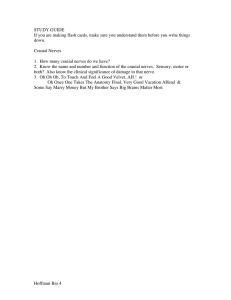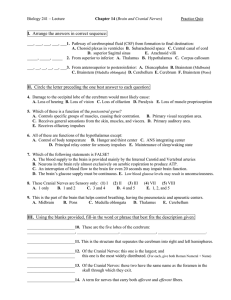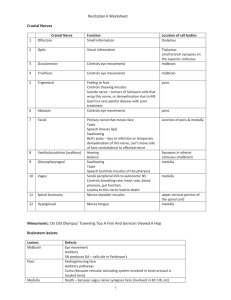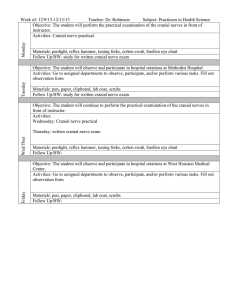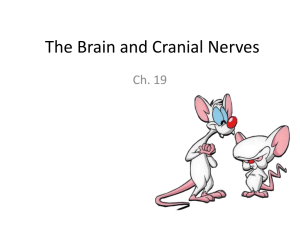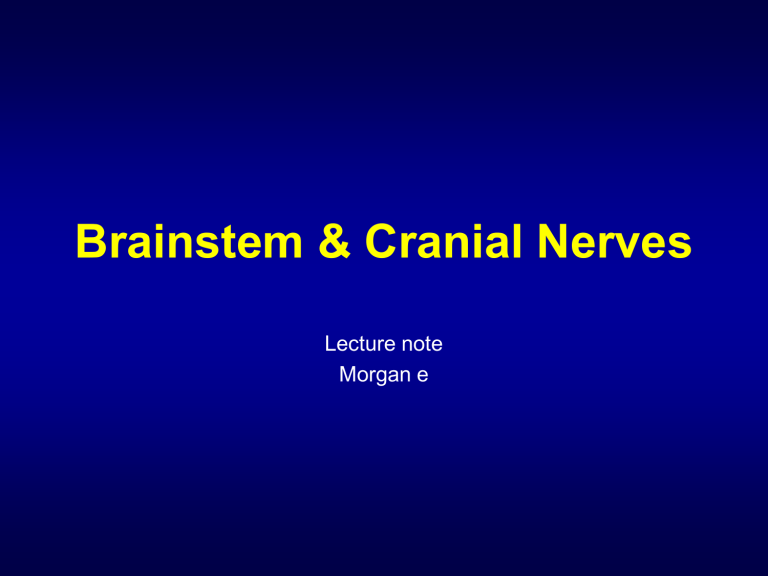
Brainstem & Cranial Nerves Lecture note Morgan e Development Ventricles in brainstem • Mesencephalon cerebral aqueduct • Metencephalon 4th ventricle • Mylencephalon 4th ventricle Corpus callosum Posterior commissure Fornix Occipital Lobe Thalamus Anterior commissure Quadrigeminal cistern Hypothalamus vermis Optic nerve 4th ventricle Mammillary body pyramid Anterior view of brainstem basal ganglia internal capsule optic chiasm optic nerve optic tract hypothalamus mammillary body cerebral peduncle interpeduncular fossa pons flocculus inferior olivary nuclear complex cerebellar tonsil cerebellum pyramidal decussation pyramid Lateral view of brainstem optic tract cerebral peduncle trigeminal nerve optic nerve middle cerebellar peduncle optic chiasm vestibulocochlear nerve flocculus hypothalamus cuneate tubercle pons inferior olivary nuclear complex anterior median fissure pyramid Posterior view of brainstem Superior colliculus Cerebral peduncle Superior cerebellar peduncle Middle cerebellar peduncle Inferior colliculus 4th ventricle Inferior cerebellar peduncle Medulla Components of the brainstem • • • • • Sensory ascending pathways (dorsal) Motor descending pathways (ventral) Cerebellar pathways Cranial nerve sensory and motor tracts CPGs: rhythmic chewing, respiration, cardiovascular regulation & gain adjustments for reflexes • Modulatory systems: locus coeruleus, raphe & substantia nigra Brainstem: 3 major divisions •Midbrain •Pons •Medulla Ascending sensory pathways Fine discriminitive touch, conscious proprioception • Fasciculus gracilis: Terminates in the nucleus gracilis (medulla) • Fasciculus cuneatus: Terminates (medulla) in the cuneate and accessory cuneate nuclei Sensations of pain and temperature • Lateral Spinothalamic Tract – origin dorsal horn cells of the gray matter – Fibers cross contralaterally through the anterior commissure and ascend to the VPL nucleus Transmits sensations of touch • Ventral Spinothalamic Tract – origin cells of the posterior horn – Fibers cross to the opposite side in the anterior commissure Descending motor pathways Voluntary movement • Lateral Corticospinal Tract – Originates in large pyramidal cells (precentral gyrus) – cross to the opposite side of the cord at the pyramidal decussation & terminate in the dorsal horn cells • Ventral Corticospinal Tract – Originates in the pyramidal cells (motor area of the cortex) Impulses related to equilibrium and antigravity reflexes • Vestibulospinal Tract – Fibers originate in the vestibular nuclei of the medulla and terminate at level of the sacral spinal nerves Connects vestibular complex and head and eye movement coordination center in medulla • Medial Longitudinal Fasciculus – Contains both ascending and descending fibers Motor Hierarchy •Lateral group (extremities; fine motor control) •Corticospinal tract •Rubrospinal tract •Medial group (axial musculature; rhythmic and postural movements) •Vestibulospinal tract •Tectospinal tract •Reticulospinal tract •“Final common path”: motor pool Reticular Formation • “Core” of brainstem (midbrain, pons and medulla) composed of loosely organized neurons, outside of the major nuclear groups of the brainstem. • Medial-to-lateral: raphe nuclei, gigantocellular region, small cell region • Participate in widespread connections • Rostral continuation of interneuronal network found in spinal cord Cerebellar pathways Conduct impulses from the leg and trunk muscles for unconscious proprioception • Dorsal & Ventral Spinocerebellar Tracts – Enter cerebellum via inferior cerebellar peduncle Summary of Spinal Cord Tracts Brainstem Internal Anatomy Components of the brainstem • Sensory ascending pathways (dorsal): – Relay nuclei, tracts • Motor descending pathways (ventral) – Tracts, motor nuclei brainstem • Cerebellar pathways – Tracts, cerebellar afferent and efferent nuclei • Cranial nerve sensory and motor tracts – Cranial nerve nuclei, nerve entry and exit points • CPGs: rhythmic chewing, respiration, cardiovascular regulation & gain adjustments for reflexes • Modulatory systems: locus coeruleus, raphe & substantia nigra – Chemically coded nuclei Dorsal Column/Medial Lemniscal system •Secondary neuron is in brainstem: nucleus gracilis and cuneatus=dorsal column nuclei •Output of dorsal column nuclei crosses midline and forms recognizable bundle: medial lemniscus •Medial lemniscus fibers synapse in the thalamus in the ventroposterior nuclei •Thalamic axons synapse in primary somatosensory cortex in several somatotopic maps with some segregation of submodalities http://cas.bellarmine.edu/tietjen/HumanBioogy/central_n ervous_system. Tracing through the brainstem: Dorsal Column/Medial Lemniscal System Corticospinal Tract Caudal Medulla Caudal Medulla “Closed” medulla Caudal Medulla Caudal Medulla Caudal Medulla Caudal Medulla Caudal Medulla Caudal Medulla Medulla Medulla Medulla Medulla Rostral Medulla Rostral Medulla Rostral Medulla Rostral Medulla Medulla-Pons Junction Medulla-Pons Junction Caudal Pons Caudal Pons Caudal Pons Caudal Pons Pons Pons Rostral Pons Rostral Pons Rostral Pons Rostral Pons Pons- Mesencephalon Junction Pons- Mesencephalon Junction Mesencephalon Mesencephalon Mesencephalon Mesencephalon Mesencephalon- Diencephalon Junction Mesencephalon- Diencephalon Junction The Cranial Nerves • The head and neck are not innervated by spinal nerves • Sensory information is received and motor information is sent via 12 cranial nerves • Considered part of the PNS they convey messages to and from the body's muscles and glands. Each cranial nerve…. • Can be referred to by a name or number! • Has a general function • Has at least a motor, sensory or parasympathetic component • Some have more than one component • Has associated brainstem nuclei • Innervates a structure(s) Cranial nerves can be identified on the ventral surface of the brain I I II III VII IV V VI VIII IX X XI XII Some tricks to learning cranial nerve numbers, names & components… I II III IV V VI VII VIII IX X XI XII Olfactory On Some Optic Occulomotor Trochlear Trigeminal Abducens Facial Auditory/Vestibulocochlear Glossopharyngeal Vagus Spinal/Accessory Hypoglossal Old Olympus Towering Tops A Frenchman And German Viewed Some Hops Say Marry* Money But My Brother* Says Big* Business* Makes Money S = Sensory M = Motor B = Both/Mixed Sensory & Motor * = Parasympathetic Arrangement of brainstem cranial nerve nuclei in columns • Midbrain • Pons • Medulla Insert picture with different levels differentiated General Rules of Thumb •Most motor nuclei are associated with a single cranial nerve •Afferent nuclei often receive fibers from several cranial nerves •All associated with a single function however, e.g., nucleus of solitary tract Functions of Cranial Nerves www.neurophys.com/EMG/Cranial_Nerves/ Cranial Nerve I: Olfactory Component: Sensory Function: Smell Tract: Olfactory cells of nasal mucosa Olfactory Bulbs pyriform cortex Cranial Nerve II: Optic Component(s): Sensory Function: Vision Tract: retinal ganglion cells optic chiasm thalamus primary visual cortex in occipital lobe Cranial Nerve III: Oculomotor Component #1: Motor Function(s): Movement of eyeball & lens accomodation Structure(s) Innervated: 4 eyeball muscles & 1 eyelid muscle Component #2: Parasympathetic Nucleus location: midbrain Function: pupil constriction Structure(s) Innervated: ciliary muscle and pupillary constrictor muscles Cranial Nerve III: Oculomotor Cranial Nerve IV: Trochlear Component: Motor Function: moves eyeball Nucleus location: midbrain Structure(s) Innervated: superior oblique muscles Cranial Nerve V: Trigeminal Component #1: Sensory(impulses of touch, pain, heat and cold) Locations of nuclei: pons & medulla Function: (1) sensations; (2) general sensory from tongue; (3) proprioception Structure(s) Innervated: (1) face, scalp, teeth, lips, eyeballs, nose & throat lining; (2) anterior 2/3 of tonque; (3) muscles of mastication Cranial Nerve V: Trigeminal Component #2: Motor Function: chewing Nucleus location: trigeminal motor nucleus in pons Structure(s) Innervated: muscles of mastication Cranial Nerve V: Trigeminal Cranial Nerve VI: Abducens Component: Motor Function: Eyeball movement Nucleus: abducens nucleus in pons Structure(s) Innervated: lateral rectus muscle of eye Cranial Nerve VII: Facial Component #1: Sensory Nucleus location: medulla Function: (1) taste & (2) proprioception Structure(s) Innervated: (1) anterior 2/3 of tongue & (2) face and scalp Component #2: Motor Nucleus location: facial motor nucleus in pons Function: facial expressions Structure(s) Innervated: muscles of the face Cranial Nerve VII: Facial Component #3: Parasympathetic Nucleus location: Superior salivatory nucleus in medulla Function: salivation and lacrimation (drooling and tears) Structure(s) Innervated: salivary and lacrimal glands via submandibular and pterygopalatine gamglia Cranial Nerve VIII: Vestibulocochlear (aka acoustic or auditory nerve) Component: Sensory Functions: (1) Balance (2) Hearing Nucleus: In pons and medulla Structure(s) Innervated: • vestibular apparatus of internal ear • cochlear of internal ear auditory cortex in the temporal lobes Cranial Nerve VIII: Vestibulocochlear (aka acoustic or auditory nerve) Cranial Nerve IX: Glossopharyngeal Component #1: Sensory Nucleus location: medulla Function: (1) taste; (2) proprioception for swallowing & (3) blood pressure receptors Structure(s) Innervated: (1) posterior two thirds of tongue; (2) throat muscles & (3) carotid sinuses Cranial Nerve IX: Glossopharyngeal Component #2: Motor Nucleus location: medulla Function: (1) swallowing and gag reflexes & (2) tear production Structure(s) Innervated: (1) throat muscles and (2) lacrimal glands Cranial Nerve IX: Glossopharyngeal Component #3: Parasympathetic Function: saliva production Structure(s) Innervated: parotid glands Cranial Nerve X: Vagus Component #1: Sensory Nucleus location: medulla Function: (1) chemoreceptors; (2) pain receptors; (3) sensations; (4) taste Structure(s) Innervated: (1) blood oxygen concentration, carotid bodies; (2) respiratory & digestive tracts; (3) external ear, larynx & pharynx (4) tongue Cranial Nerve X: Vagus Component #2: Motor Nucleus location: medulla Function(s): (1) heart rate & stroke volume; (2) peristalsis; (3) air flow; (4) speech & swallowing Structure(s) Innervated: (1) pacemaker & ventricular muscles; (2) smooth muscles of the digestive tract (3) smooth muscles in bronchial tubes (4) muscles of larynx a & pharynx Cranial Nerve X: Vagus Component #3: Parasympathetic Structure(s) Innervated: smooth muscles and glands of the same areas innervated by motor component, as well as thoracic and abdominal areas Cranial Nerve XI: Spinal Accessory Component: Motor Function: head rotation (& shoulder shrugging!) Nucleus location: accessory nucleus in medulla trapezius & sternocleidomastoid muscles Structure(s) Innervated: Cranial Nerve XII: Hypoglossal Component: Motor Function: Speech and swallowing Nucleus location: In medulla Structure(s) Innervated: Throat and tongue muscles Cranial Nerve XII: Hypoglossal Dorsal Column/Medial Lemniscal system •Secondary neuron is in brainstem: nucleus gracilis and cuneatus=dorsal column nuclei •Output of dorsal column nuclei crosses midline and forms recognizable bundle: medial lemniscus •Medial lemniscus fibers synapse in the thalamus in the ventroposterior nuclei •Thalamic axons synapse in primary somatosensory cortex in several somatotopic maps with some segregation of submodalities http://cas.bellarmine.edu/tietjen/HumanBioogy/central_n ervous_system.

